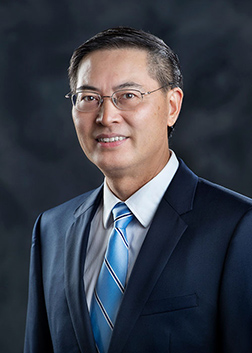Wang uses new method to study plasma with funding from DOE

Chuji Wang
Chuji Wang, a professor in the Department of Physics and Astronomy at Mississippi State University, is the recipient of a $199,000 grant from the Department of Energy’s Discovery Plasma Science: Measurement Innovation Program to study the effects of plasma in complex settings using a novel method -- the cavity ringdown spectroscopy (CRDS) technique.
The Measurement Innovation Program supports the development of novel and groundbreaking diagnostic techniques and their applications to new, unexplored or unfamiliar plasma regimes or scenarios.
Wang’s proposal “Time-, space- and molecule-resolved multiple plasma reactive species in complex settings using an innovative approach of cavity ringdown spectroscopy” received a 24-month grant to demonstrate the feasibility of the state-of-the-art approach by measuring reactive species (RS) in challenging settings—on the surface of water as well as under the water.
Wang hopes this CRDS system will enhance the diagnostics and measurement capabilities of low temperature plasma. LTP has broad applications stemming from interactions of the LTP agents—RS, electrons, and ultraviolet light—with a targeted medium.
“Knowing the absolute concentration of LTP RS in time and in space remains one of the most challenging yet most important LTP diagnostic tasks,” Wang said. “This challenge is further compounded when an LTP source is set for interactions with a wet medium such as a biological surface, where the interface between the plasma gas and the liquid forms a time- and space-dependent multiphase reaction zone, or interfacial reaction zone.”
Wang said the behavior of the RS in interfacial reaction zones is largely unexplored because of technical challenges, which hinders researchers’ understanding of the complicated physics, gas dynamics and heterogeneous chemistry of LTP in the complex settings.
Wang’s research career at MSU has involved laser-induced fluorescence spectroscopy of free radicals, laser photolysis/laser-induced fluorescence spectroscopy of large alkoxy radicals and the development of plasma-cavity ringdown spectroscopy, all involving physics, chemistry and optical engineering. He seeks to develop and apply measuring, monitoring and sensing technologies to address problems in energy, the environment and biomedical engineering.
MSU’s College of Arts and Sciences provides diverse units for research and scholarly activities, including natural and physical sciences, social and behavioral sciences, and the humanities. For more details about the college or the Department of Physics and Astronomy, visit www.cas.msstate.edu or www.physics.msstate.edu.
MSU is Mississippi’s leading university, available online at www.msstate.edu.
Sarah Nicholas | College of Arts and Sciences



